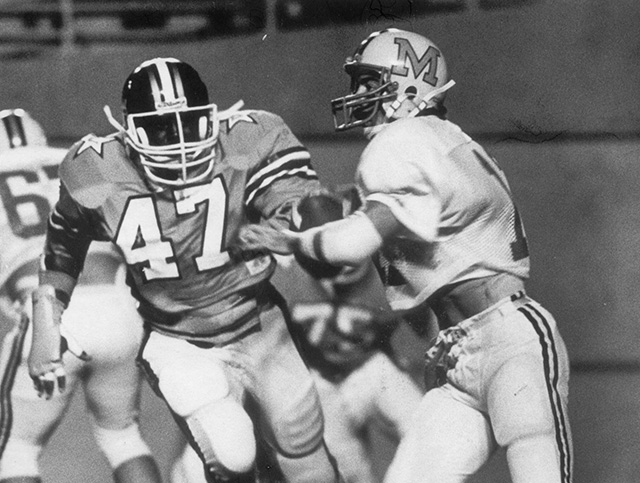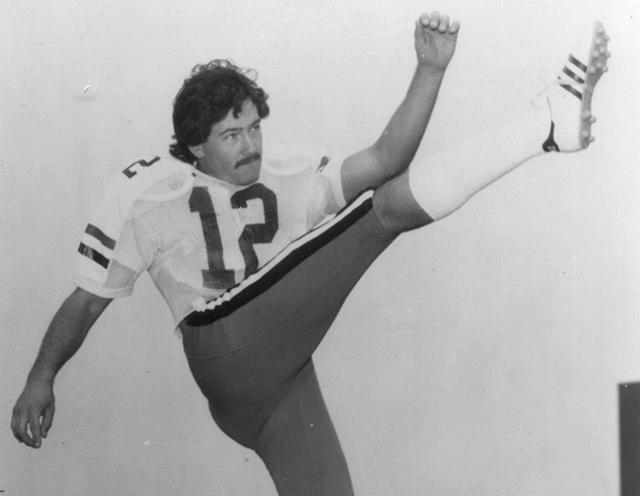Sept. 16, 2014

Commodore History Corner Archive
On Oct. 14, 1922, Vanderbilt dedicated its new football stadium at a cost of $300,000. The new Dudley Field seated 22,000 fans, which was at the time the first football-only stadium in the South. Commodore captain Jess Neely led his squad that day to a 0-0 hard-fought tie against the powerful Michigan Wolverines.
Nearly 59 years later on Sept. 12, 1981, Neely stood on the same field for a ceremony to dedicate a renovated Dudley Field, which would be officially named thereafter as Vanderbilt Stadium. Neely, who was 79 years old, was a retired Vanderbilt athletics director and said, “It takes me back a few years when we played the University of Michigan and they were lucky to tie us.”
Vanderbilt Chancellor Alexander Heard presided over the pre-game ceremony on a night of speeches, music and fireworks. The new stadium seated 41, 000 with a $12 million construction cost that included a new press box and suites. New artificial turf was also installed on the field. John Bibb, sports writer for the Tennessean, wrote:
“The new stadium is really a monument to thousands of people around the world. This group includes the university campus and athletic administrators, faculty, alumni, staff members, trustees, friends, students, former athletes and coaches. It’s their contributions, financial and otherwise, that has made this concrete and steel structure a reality.
“As coach Bill Pace once said during his stay here as head coach of the Commodores: “there has to be a special place in the Great Beyond for Vanderbilt football fans. Where else in the world have there been 15,000-20,000 people so faithful for so long for so little.”
As far as the game itself, the 13-point underdog Commodores stunned the Maryland Terrapins 23-17. Bibb wrote:
Vanderbilt’s Commodores threw one hellacious housewarming last night, dedicating their new football stadium with a blazing 23-17 upset over Maryland. It was such a goodtime bash that nobody wanted to leave. Not the fans, not the Commodores. In an unprecedented football scene, the record crowd of 38, 624 fans stood and roared for an encore, demanding the gold-shirted Commodores return to the field for one final curtain call.
And when they did come back, the thunderous ovation reflected the full appreciation of what had been a spiffy execution of a well-devised game plan and well earned victory over the two touchdown favorite Terps. Even the heavens cooperated on this night of nights for Commodore supporters. A full moon glistened above the throng and seemed to add one extra touch of luster to the entire evening. For sure, this was a special night, football was fun once more at Vanderbilt.
It was fun because the Commodores combined a dazzling imaginative offense with an old-fashioned, slam-banged defensive effort. In the end, the ambushed Terrapins couldn’t match the moment. It was fun because there were Vandy heroes all over the place. None shared more of the glorious night than quarterback Whit Taylor, the poised Commodore who threw for both Vandy touchdowns enroute to a school record 26 pass competitions.
It was fun because little Norman Jordan hung on to one of Taylor’s scoring tosses and because Phil Roach grabbed another and danced just past the gold line pylon for a five-yard winning TD with about five minutes left. It was fun because field goal kicker Mike Woodard booted three field goals, two of them for 42 yards and a 38-yard icer with 52 seconds to go.
It was fun because linebacker deluxe Andrew Coleman leveled Terrapin ball carriers 13 times during the evening to lead the spirited Commodore defenders who contained Maryland’s menacing ground game for a total of 121 yards, 104 of them by the Terp All-American candidate Charlie Wysocki.
It was particularly fun for the very active Coleman who bounced Wysocki for a 2-yard loss inside the Commodore 5 on a second-period play that surely was one of the keys to the upset.
George MacIntyre was in his third season guiding the Commodore football program. Vanderbilt scored the only points in the first quarter with a 42- yard field goal by Woodard. The Terps responded with a touchdown and a field goal in the second period for a 10-3 lead. Again, Woodard connected on a 42-yarder for three more points and later Jordan stood in the end zone grabbing an acrobatic touchdown pass from Taylor that covered one yard. Woodard’s PAT gave the Commodores a 13-10 halftime advantage.

The third quarter was scoreless, but Maryland scored a touchdown early in the fourth for a 17-13 lead. Ten minutes remained when the Black and Gold began moving the ball from their 14-yard line to match 86 yards in 13 plays. The 13th play was a five-yard toss from Taylor to receiver Roach for a touchdown. The extra point by Woodard gave the ‘Dores a 20-17 lead with 5:17 left. Woodard added a 38-yard field goal to cap the scoring for a 23-17 victory.
The Vanderbilt players left the field at the close of the game, but the fans would not leave their seats. The players left the new locker room under the south end zone to return to the field to celebrate with their fans.
Taylor, a redshirt junior, was 26-of 41 for 259 yards and two touchdowns. Jordan hauled in eight passes for 95 yards. On the defensive side, Coleman leveled 13 Terrapins while punter Jim Arnold averaged 44 yards per punt.
Former Vanderbilt quarterback Watson Brown was in his first season as Vanderbilt’s offensive coordinator after leaving Austin Peay as its head football coach. Jerry Claiborne was Maryland’s head coach while his quarterback Bob Milkovich was 13-of-20 for 147 yards for the game.
“What courage Whit Taylor has,” Brown said. “I know it’s easy to say now, but I was behind him all along. I knew he could run the offense. Tonight the receivers made all the catches, some of them great ones; the line gave great protection and the defense gave us the ball in the position where we could open it up early. It allowed us to see what we could do quickly and have the rest of the game to open up some more.
“Our game plan was perfect. We used every play we had thought would work. You preach confidence, but there is nothing like a win over a great defensive team like Maryland to really generate it.”
David Nolan was a 77-year old Nashvillian seated in the west side stands and remembered going to a Vanderbilt game in 1910 that was a win over Georgia. That game was played on the original Dudley Field that hosted football games from 1892-early 1922. After the dedication of the new Dudley Field in 1922, the old field was renamed Curry Field for Irby “Rabbit” Curry, a former Vanderbilt quarterback killed during World War I.
Said Nolan: “I had to come tonight, even though I can’t see the ball half the time. This makes the cycle for me nowâ€â€all three fields and two new stadiums.”
Traughber’s Tidbit: Recently two former Vanderbilt basketball players passed away. Bob Warren (1966-68) died on Aug. 25 at age 67 and Dave Kardokus (1950-52) on Sept. 6 at age 84.
Warren was a First Team All-SEC selection and an All-American at Vanderbilt as a senior. He played professionally in the American Basketball Association from 1968-1976 with the L.A. Stars, Memphis Pros, Carolina Cougars, Dallas Chaparrals, Utah Stars, San Antonio Spurs and San Diego Sails.
Kardokus was a First Team All-SEC selection and part of coach Bob Polk’s first full scholarship class with Jack Heldman, Gene Southwood and Bob Smith. Kardokus led the Commodores in a 61-57 upset win over Kentucky in the 1951 SEC Tournament. That was the first and last SEC Tournament championship for Vanderbilt in either era until 2012.
If you have any comments or suggestions contact Bill Traughber via email WLTraughber@aol.com.


